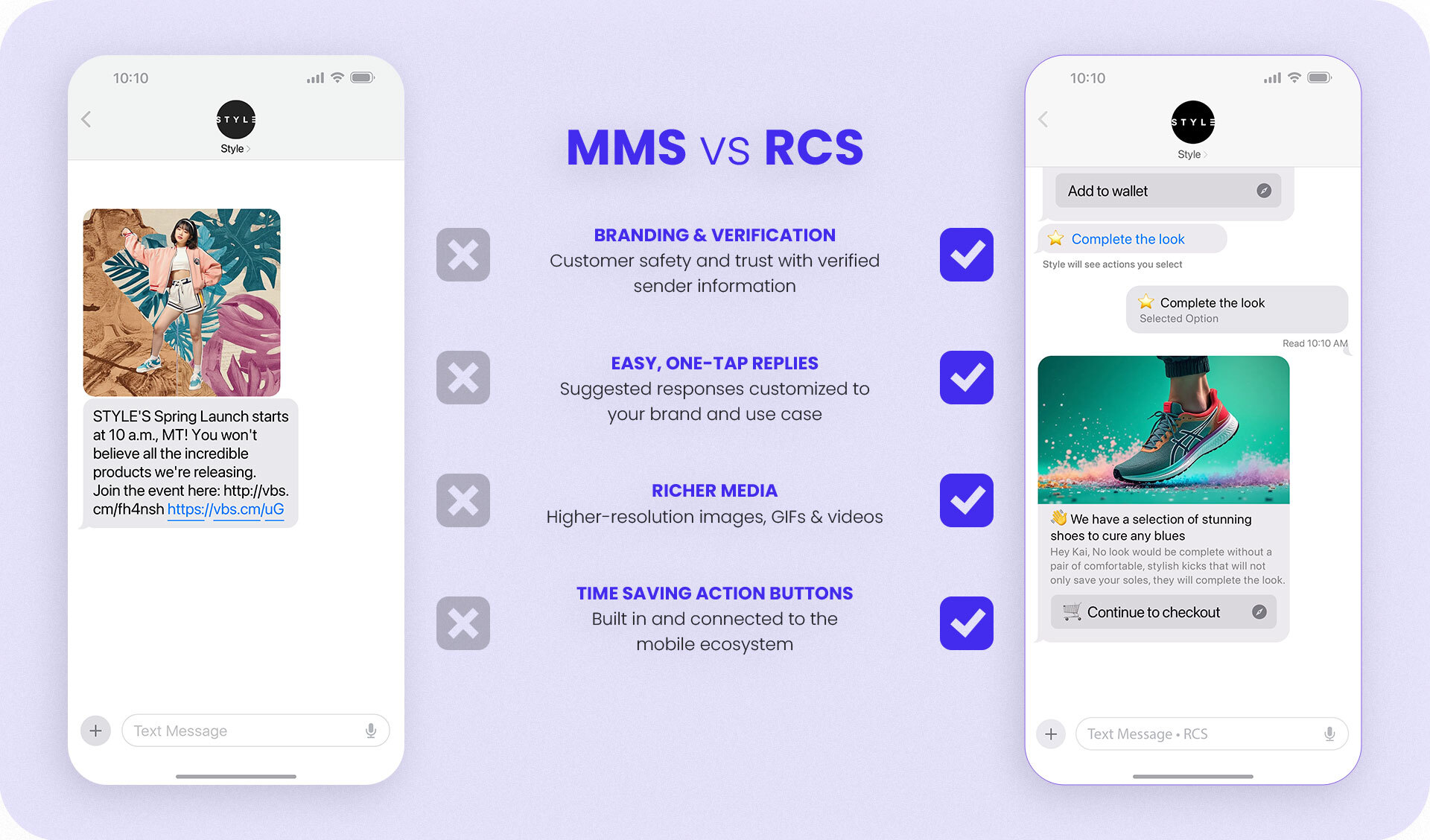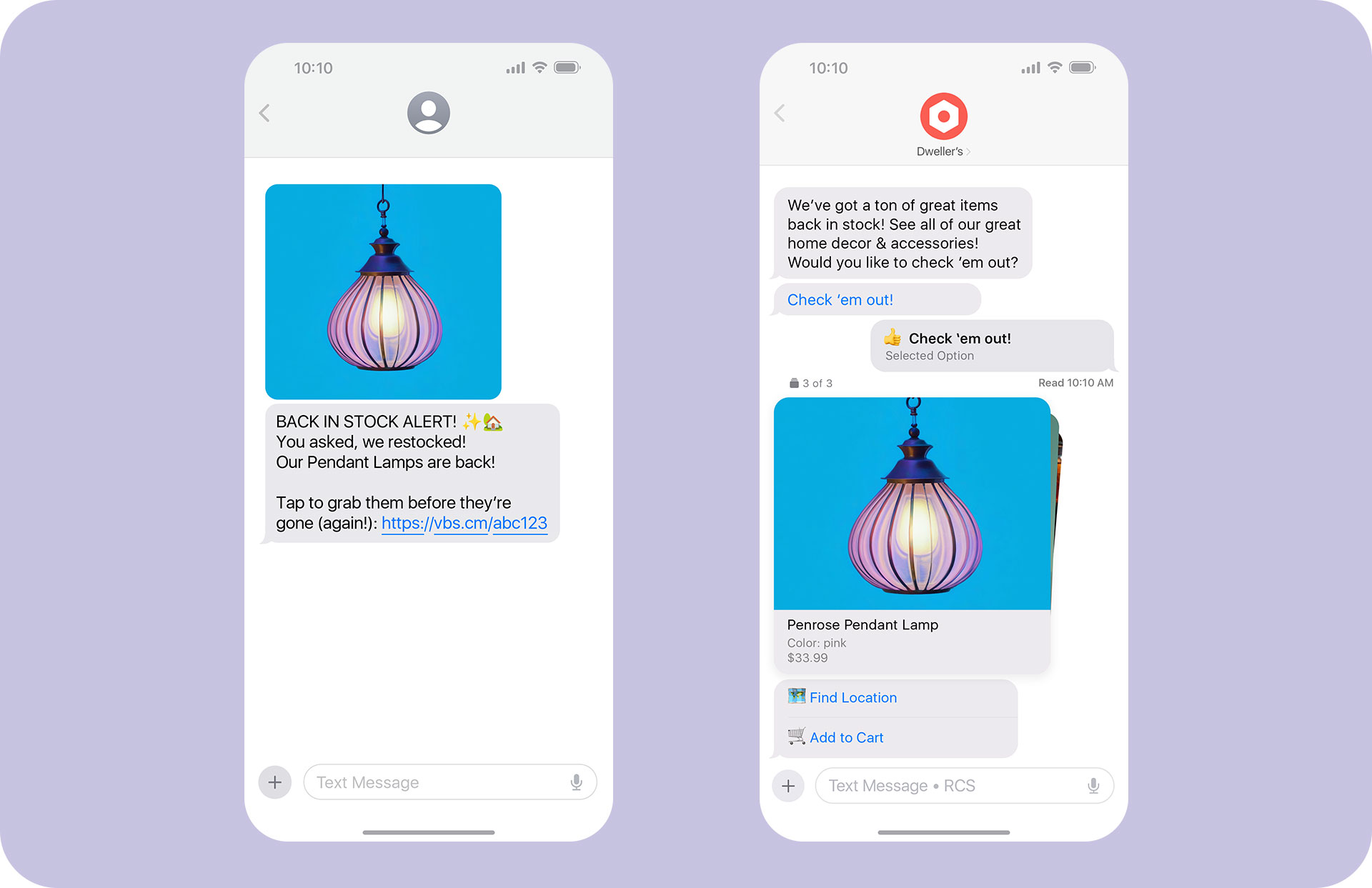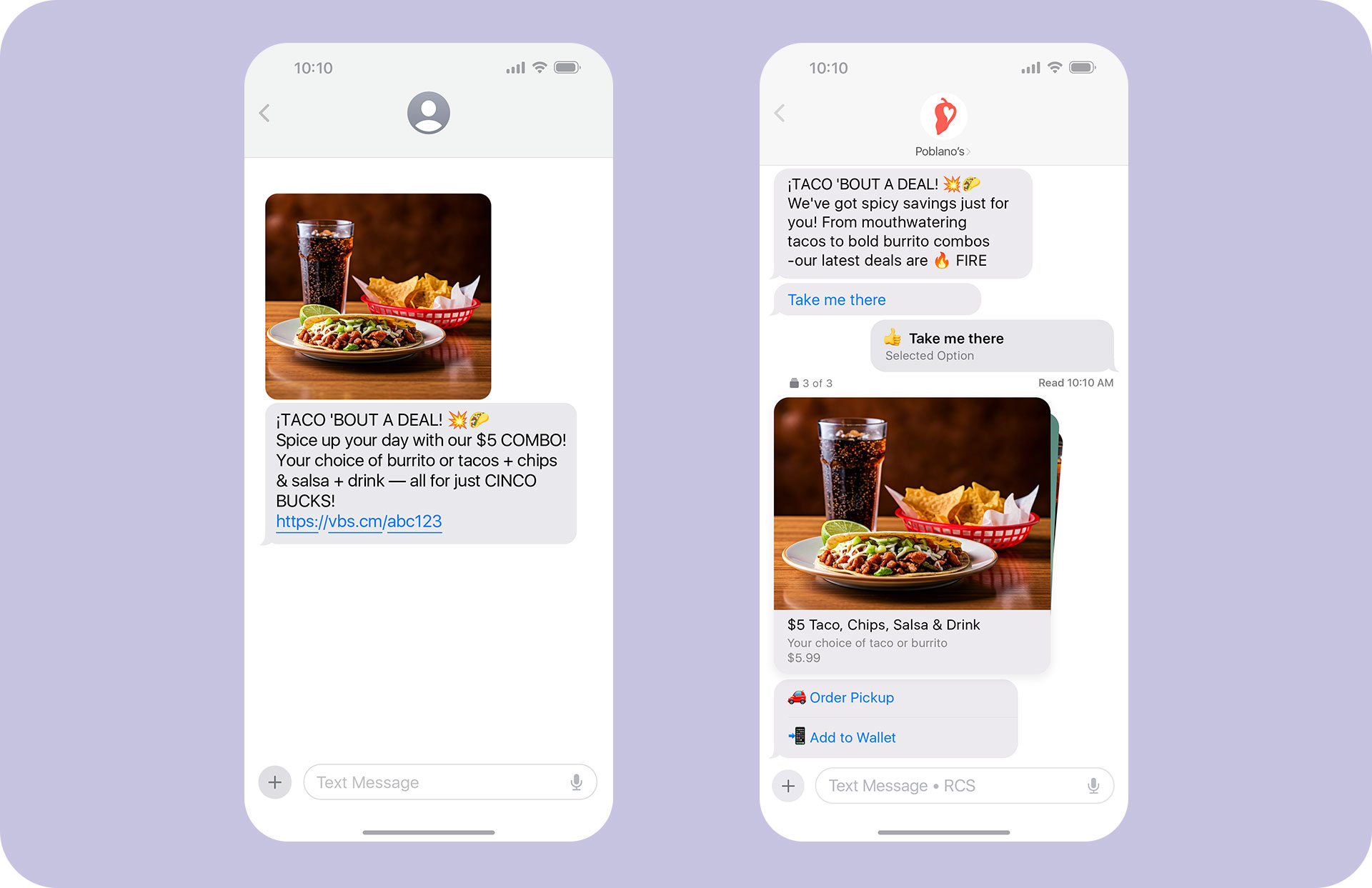
Today’s mobile marketers have more tools at their disposal than ever before — and while new options mean new opportunities, they also make it harder to know what to use and when.
If you’re running MMS marketing campaigns, you might be wondering what Rich Communication Services (RCS) actually adds to the mix — and whether it’s worth the switch.
Spoiler: It is.
RCS is quickly becoming the new standard for business messaging with a richer, branded, app-like experience. Understanding the differences between RCS and MMS is key to determining how your mobile marketing strategy should evolve.
Here’s what every mobile marketer needs to know.
What is RCS?
RCS (Rich Communication Services) is a next-gen messaging format that upgrades the capabilities of traditional text and multimedia messages. It enables companies to send branded messages with interactive options like carousels, tappable buttons, and engagement tracking. Essentially, RCS marketing can deliver the experience users are used to seeing in an app, and not in their texts.
Unlike SMS or MMS, RCS messages don’t come from a short code or phone number. Instead, messages are sent from your verified brand profile — also known as an RCS agent— making them instantly more recognizable and trustworthy to your customers.
In terms of pricing, a single RCS message is generally more expensive than an MMS message. RCS experiences also often include multiple messages in a single flow (such as welcome sequences, interactive carousels, or responses to button taps), which increases overall costs depending on how your campaign is structured.
As of 2025, RCS is supported across all major U.S. carriers and available on both Android and iOS, giving it comparable reach to MMS and rapidly growing. That said, device compatibility can still vary, especially internationally or with older devices, so brands should ensure fallback messaging is in place.
What Is MMS?
MMS (Multimedia Messaging Service) lets you send images, videos, and audio clips to a mobile device. It’s a step up from plain-text SMS, and for years, it’s been the go-to way to add visual interest to a mobile campaign.
However, MMS stops short of offering deeper engagement. When a customer receives an MMS message, it’ll come to their mobile device as a short code or phone number, and not as your brand name. MMS also doesn’t support interactivity or robust analytics, and image/video file sizes are limited.
In terms of reach, MMS is almost universally compatible with every device.
What’s the difference between RCS and MMS?
RCS is more than a step up from MMS; it’s a leap. While both formats let you include media, only RCS adds interactivity, branding, and real-time feedback within an app-like interface. Here’s how they stack up:
1. Interactivity
RCS enables buttons, quick replies, carousels, and more. MMS is static, with no next steps built in.
2. Branding
RCS messages come from a verified business profile with your logo and brand colors. MMS comes from a short code or phone number with no visual identity.
3. Analytics
RCS gives marketers read receipts, click data, and engagement paths. MMS gives basic delivery metrics.
4. Experience
RCS offers a seamless, app-like feel — with product browsing, wallet passes, and more, all inside the messaging thread. MMS offers a static image or short video.
5. Media Quality
MMS messages are constrained by tight size caps, often only a few megabytes, meaning images need heavy compression and videos must be short and low-resolution. In contrast, RCS supports media sizes that are typically 100x larger, allowing for crisp, HD visuals, longer videos, and multiple rich assets in a single message — without the usual pixelation or choppiness of MMS.
6. Reach
RCS is now widely supported across Android and iOS in the U.S. and includes fallback logic to SMS/MMS. However, some older devices may not support RCS. MMS works on almost all devices.
7. Setup & Scalability
RCS requires creating a verified business profile (also called an RCS agent) and getting Google and carrier approval. This can take 4–6 weeks, though Vibes can help you test in 24 hours. MMS setup is faster, requiring only number provisioning and carrier registration. The timeline varies depending on the method, with a toll-free or registered 10DLC number ready in as little as a few days, while setting up a new short code can take weeks.

RCS vs MMS: How are they similar?
Both RCS and MMS support images and videos and live inside the user’s default messaging app. The visual interest they add to a basic text message has made it an effective strategy for mobile marketers for years.
But when it comes to what mobile messaging can do next, MMS is starting to show its age. RCS takes what people love about MMS and levels it up with higher quality visuals, branded design, clickable calls to action, live data, and app-like experiences.
What does this mean for SMS?
SMS still matters. It’s the most universal format in mobile messaging and the cheapest. That makes SMS an essential fallback option for any campaign.
But SMS comes with tradeoffs. It’s plain text only, and there’s no opportunity to visually represent your brand. While effective for urgent messages or two-factor authentication, SMS doesn’t offer deeper engagement.
There are a few use cases where SMS may always stick around: account notifications, password resets and delivery confirmations. For everything else, richer formats like MMS and RCS offer a better, more engaging experience for customers.
So, when should you actually use MMS over RCS?
While RCS messages can be a more immersive app-like experience, they don’t have to be. An RCS message can look just like a simple SMS or MMS message (and can be as simple to send), but customers will receive it from your verified brand versus a short code or unsaved phone number.
So if you’ve set up an RCS agent, why send any message via MMS? If you have a flash sale and you need to send a message ASAP, it’s just as easy to send an RCS message versus an MMS message.
There's a clear benefit to even a simple message coming from your brand’s RCS agent. Compared to SMS campaigns, messages sent through a verified RCS agent consistently outperform both engagement and revenue. Vibes customers using RCS have seen a 3x lift in engagement and 30% more revenue compared to similar campaigns sent via SMS/MMS. That means sending a single RCS message will most likely drive higher results than sending the message via MMS.
Here’s the breakdown of when you should use each channel:
RCS is ideal for:
- Any message you would prefer to send from your brand’s name and not a short code or phone number
- You want immersive, branded messaging
- You need real engagement metrics
- You’re showcasing multiple products
MMS is useful when:
- You want to send a lower-cost campaign
- You have not yet set up your brand’s RCS agent
- You already have creative formatted for MMS
RCS vs. MMS Use Cases
Still unsure how the same campaign can look and perform differently in MMS versus RCS? Here are a few side-by-side examples that show how the format you choose can impact the user experience.
1. Back-in-Stock Alert
When a high-demand item is restocked, it’s critical to notify customers fast. Using MMS, you can drive urgency with visuals. Using RCS, you can push customers to buy without ever leaving the text thread.

2. Flash Sale Promo
Flash sales are all about speed and excitement. MMS is a great, familiar format to use for a last-minute promo that needs to reach as many customers as possible. RCS is a great way to push customers to purchase without navigating to a website or app.

3. Limited-Time Meal Deal (QSR)
Limited-time deals are great for increasing restaurant revenue outside of peak hours. Sending your message via MMS can help you tempt customers with mouth-watering visuals, while sending with RCS gives you the opportunity to spur customers to take action right away.

Why marketers choose Vibes for RCS messaging.
Vibes is the only mobile engagement platform in North America with direct carrier connections, meaning you won’t have to jump through multiple hoops or work with other 3rd parties to get your messaging campaigns approved.
Plus, brands that use Vibes’ RCS platform gain the advantage of our years-long relationships with Google and Apple. We have live RCS agents already working on all wireless carriers, and we are actively registering and verifying brands that want to be among the first to activate RCS.
Interested in seeing RCS in action? Text RCS to 84237 to interact with a live Vibes RCS agent.
The bottom line.
Don’t throw out MMS just yet — it’s still a powerful tool for marketers who need a reliable, familiar medium to drive revenue with customers.
However, the promise of RCS should not be ignored — it’s not just a messaging channel, it’s a powerful platform for building interactive, app-like experiences directly in your customer’s trusted messaging app.
Ready to see what RCS can do for your brand? Talk to us.






